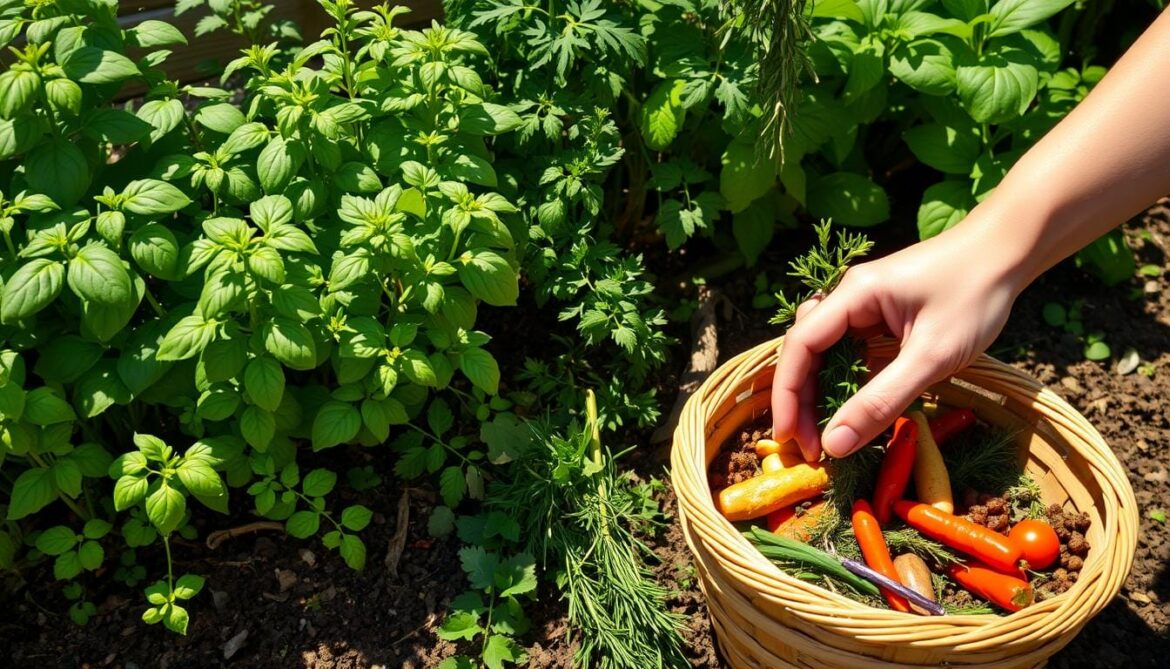My first time in the backyard garden was eye-opening. Spice cultivation is more than growing plants. It’s about creating a pantry full of flavors.
Harvesting spices connects us to old culinary traditions. We’ll show you how to turn your garden into a place of fresh seasonings. This will make every meal better. From knowing when to pick to mastering harvesting techniques, we’ll share the secrets of growing spices.
Our spice cultivation tips include timing, technique, and keeping them fresh. Fresh herbs and spices have flavors that store-bought can’t match. Picking at the right time ensures the best taste.
Key Takeaways
- Master the art of identifying peak harvest times
- Learn proper harvesting techniques for different spice types
- Understand the importance of timing in preserving flavor
- Discover methods to maximize your spice yield
- Explore sustainable home spice production strategies
Understanding the Basics of Home Spice Production
Spice farming at home is exciting for garden lovers. Our guide will show you how to turn your garden into a colorful, aromatic space.
To gather spices, you need to know about different herbs and spices. Let’s explore the key steps to grow your own spice garden.
Types of Spices You Can Grow at Home
Not all spices are the same. Some grow easily in home gardens, while others need special care.
- Annual Herbs (Soft Herbs):
- Cilantro
- Dill
- Parsley
- Basil
- Perennial Herbs (Woody Herbs):
- Rosemary
- Thyme
- Oregano
- Exotic Spices:
- Turmeric
- Cardamom
- Chili Peppers
Essential Tools and Equipment
Good tools are key for growing and harvesting spices.
| Tool Category | Recommended Items |
|---|---|
| Gardening Tools | Pruning shears, hand trowel, gardening gloves |
| Harvesting Equipment | Drying racks, mesh screens, storage containers |
| Maintenance | Watering can, spray bottle, liquid fertilizer |
Ideal Growing Conditions
Creating the perfect environment is key for growing spices. Most herbs need specific conditions to grow well.
“The secret to a bountiful spice garden lies in understanding each plant’s unique needs.” – Home Gardening Expert
- Sunlight: 6-8 hours of direct sunlight daily
- Soil: Well-draining, nutrient-rich potting mix
- Container Size: 10-18 inches in diameter
- Watering: Consistent moisture without waterlogging
With dedication and the right approach, your spice farming journey can be rewarding. Start small, learn from each season, and enjoy growing your own spices.
Best Time to Start Harvesting Spices
Timing is key when picking your homegrown spices. Knowing when to harvest can greatly affect their taste and strength.
Our expert gardeners say to pick herbs in the early morning. This is after the dew has dried but before it gets too hot. This time ensures your spices have the best flavor.
“The secret to vibrant spice seasonings lies in knowing exactly when to harvest.”
Here are some tips for harvesting:
- Harvest when plants have enough leaves
- Cut up to 75% of the current season’s growth
- Choose bigger leaves to help the plant grow more
- Snip herbs before they flower for better taste
Each herb has its own best time to harvest. Here’s a quick guide for some common ones:
| Herb | Best Harvest Time | Yield Considerations |
|---|---|---|
| Rosemary | Mid-summer | Trim 1/4 of branch |
| Basil | Early morning | Regular cutting promotes growth |
| Thyme | Before flowering | Maximum flavor preservation |
Pro tip: Regular harvesting encourages fuller, more robust herb growth throughout the season.
Essential Tools for Harvesting Spices at Home
Starting your spice processing journey requires the right tools and equipment. Our guide will prepare you for a successful organic spices harvest. You’ll learn about the most important tools and safety gear.
Hand Tools for Precise Harvesting
Choosing the right tools is key to a high-quality harvest. Here are some essential hand tools for spice processing:
- Felco pruners: Reliable for precise cutting with multiple sharpening options
- Sharp kitchen scissors for delicate herb collection
- Hori-hori weeding knife for robust root harvesting
- Digging fork for minimal root damage
Storage Containers and Materials
Proper storage is vital for keeping your organic spices fresh. Consider these storage solutions:
- 3-5 gallon food-grade harvesting buckets
- Well-sealed glass jars for dried herbs
- Dark, cool storage areas like closets or cabinets
Safety Equipment for Harvesting
Protecting yourself while processing spices is essential. Invest in these safety items:
- Two pairs of gloves: thin for delicate tasks, thick for protection
- Hand lens (10x-20x magnification) for plant identification
- Sturdy bristled brush for root cleaning
- Eye protection during harvesting
“The right tools transform spice harvesting from a chore into an art.” – Organic Farming Quarterly
With these essential tools, you’ll have a safe, efficient, and high-quality spice harvesting experience.
Identifying When Your Spices Are Ready for Harvest
Harvesting spices is an art that needs careful watching and timing. Knowing when to pick can greatly affect the taste, strength, and quality of your homegrown spices.
Our expert gardeners say to watch for these signs that your spices are ready:
- Leaf color and texture changes
- Plant height and stem development
- Essential oil concentration
- Pre-flowering stage
“The secret to perfect harvesting is understanding your plant’s unique growth cycle.” – Herb Cultivation Experts
For most herbs, the best time to harvest is just before they flower. Early morning harvests are best because essential oils are at their highest and moisture is perfect. Herbs like basil, oregano, and cilantro should be picked when stems are 6-8 inches long and before they flower.
Different spices need different harvesting methods:
- Leafy herbs: Harvest before flowering
- Seed-producing herbs: Wait until seed pods turn brown
- Root spices: Check maturity by plant die-back
Regular harvesting keeps flavors at their best and helps plants grow well. By picking mature stems often, you encourage more growth and prevent plants from getting too long. This makes your spice growing efforts more successful.
Proper Techniques for Harvesting Spices
Spice gathering is an art that needs careful attention and sustainable practices. Our guide will teach you the essential techniques for harvesting spices. This way, you’ll keep their quality and flavor intact.
Knowing the right harvesting methods is key to the potency and taste of your spices. Each type of spice needs a special approach for the best collection and preservation.
Leaf Harvesting Methods
Timing is everything when collecting leafy spices. Here are some strategies for successful leaf harvesting:
- Harvest in the morning after dew has dried
- Cut no more than one-third of the plant’s growth
- Choose leaves at peak oil content (mid-morning)
Seed Collection Techniques
Seed harvesting needs precision and patience. Here’s our recommended approach:
- Wait until seed heads are fully mature
- Collect seeds when they are dry and easily detach
- Use clean, sharp tools to minimize plant damage
Root Spice Harvesting
Root spices need careful extraction to keep the plant healthy and sustainable:
| Spice Type | Harvest Time | Drying Duration |
|---|---|---|
| Turmeric | 9-10 months after planting | 3-7 days |
| Ginger | 8-10 months after planting | 4-7 days |
| Horseradish | Late fall or early spring | 3-5 days |
“Sustainable harvesting isn’t just about collecting spices—it’s about nurturing your plants for future growth.”
By following these techniques, you’ll get a bountiful and high-quality spice harvest. Plus, you’ll keep your plants healthy.
Post-Harvest Processing Methods
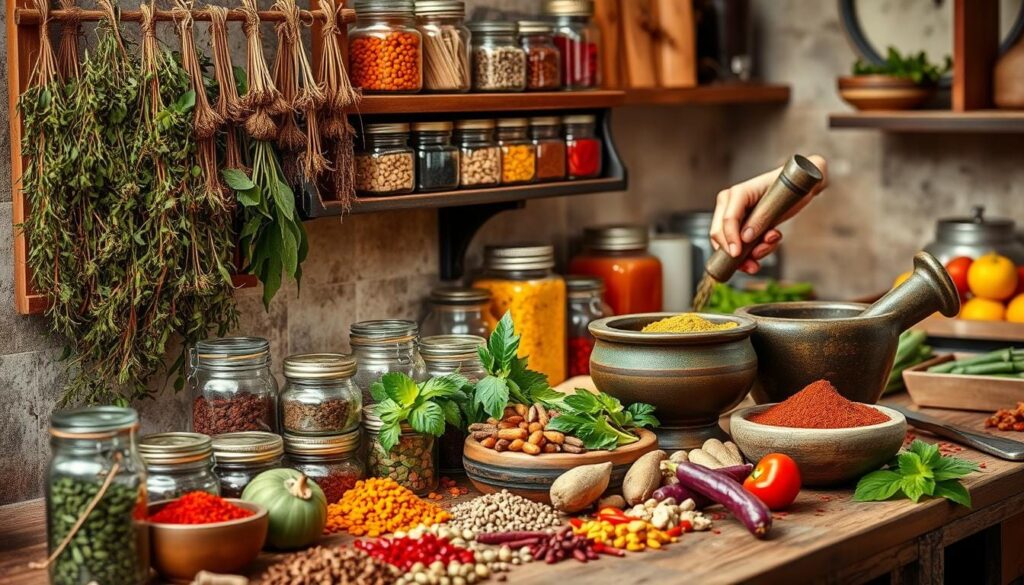
Spice processing turns fresh herbs and seasonings into top-notch artisanal spices. Our methods make sure each spice keeps its flavor, aroma, and nutrients.
“Proper post-harvest handling determines the ultimate quality of your homegrown spices” – Culinary Herb Experts
The first steps in spice processing are cleaning and getting ready. Here are the key steps:
- Rinse harvested herbs in cold water
- Gently pat dry with clean towels
- Remove any damaged or discolored leaves
- Sort spices by variety and quality
Each spice needs its own special way of processing. We focus on keeping essential oils and preventing flavor loss.
| Spice Type | Processing Technique | Temperature Requirement |
|---|---|---|
| Basil | Cool storage at 40°F | Above 50°F air temperature |
| Cinnamon | Inner bark peeling | Room temperature drying |
| Cloves | Sun-drying to reddish-brown | Direct sunlight exposure |
Our artisanal spices get strict quality checks. We look at impurities, flavor, color, and aroma. We also use sustainable methods to reduce waste and increase crop value.
Pro Tip: Always process spices as quickly as possible after harvesting to maintain peak flavor and nutritional content.
Drying and Curing Your Harvested Spices
Keeping the taste and quality of your homegrown spices is key. We’ll show you how to dry them right. This way, your organic spices stay strong and flavorful.
First, you need to know about moisture. Fresh herbs have about 80% water. But we aim for 10% moisture for the best storage. This keeps your spices tasty and mold-free.
Air-Drying Techniques
Air-drying is a classic way to keep your spices fresh. Here are our best tips:
- Harvest herbs on a sunny morning after dew has evaporated
- Cut stems leaving 4-6 inches for future growth
- Tie herbs in small bundles using rubber bands
- Hang in a well-ventilated area with low humidity
- Ensure leaves do not touch to prevent moisture buildup
Oven-Drying Methods
If air-drying isn’t possible, oven drying is a good backup. Caution is key – keep temperatures below 180°F. This helps keep the oils and flavors intact.
- Spread herbs on a baking sheet
- Use lowest oven setting
- Dry for approximately 30 minutes
- Check frequently to prevent burning
Microwave Drying Options
For the quickest method, try microwaving. Most herbs dry in about one minute. You might need to add 30 seconds more as needed.
“Proper drying transforms fresh herbs into concentrated flavor bombs for your culinary creations.”
Dried herbs are much stronger than fresh ones. One tablespoon of fresh herbs is like one teaspoon of dried. So, your homegrown spices are very valuable.
Storage Solutions for Fresh and Dried Spices
Keeping your artisanal spices fresh is key. Our guide will show you how to keep your homemade spice seasonings fresh and flavorful for months.
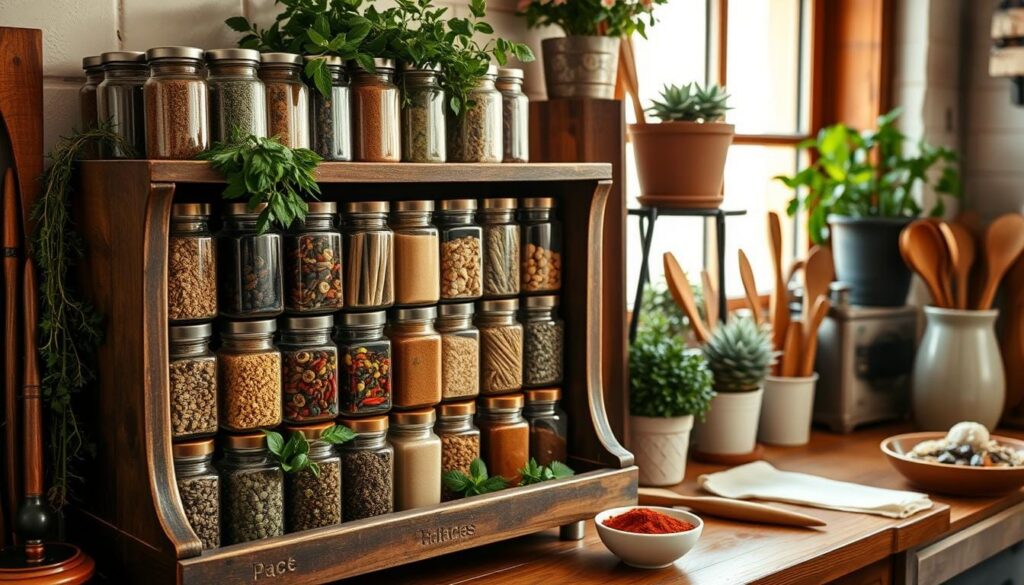
Storing spices right is essential. The best place keeps them away from moisture, light, and temperature changes. These can harm their taste and strength.
“The secret to long-lasting spices is understanding their preservation needs”
Best Storage Containers for Spice Preservation
- Airtight glass jars with tight-sealing lids
- Vacuum-sealed bags for maximum freshness
- Dark-colored containers to block harmful light
- Ceramic containers with rubber gaskets
When storing your homegrown spices, follow these tips:
- Label each container with the spice name and harvest date
- Store in a cool, dark place around 70°F
- Keep away from direct sunlight and heat sources
- Use smaller containers to minimize air exposure
Pro tip: Whole spices typically last 2-3 years, while ground spices maintain optimal quality for 1-2 years.
| Spice Type | Recommended Storage Duration |
|---|---|
| Whole Spices | Up to 3 years |
| Ground Spices | 1-2 years |
| Salt | Indefinite |
By using these storage tips, you’ll keep your spice seasonings fresh. Your kitchen will become a place of delicious, aromatic dishes.
Seasonal Guide to Harvesting Spices
Knowing when to harvest spices is key to successful spice farming. Our guide will help you get the best spices from your garden. This way, you can enjoy the highest quality spices all year.
Each spice has its own best time to pick. Picking at the right time can make your spices taste better and be more potent.
Spring Harvesting Strategies
Spring is a great time for picking spices. We suggest focusing on herbs that do well in cooler weather:
- Plant cool-season annual herbs between September and February
- Harvest herbs in the morning when essential oil concentrations are highest
- Focus on delicate herbs like cilantro and fenugreek
Summer Collection Timeline
Summer is when you can pick many spices. Here’s what we recommend:
- Collect green cardamom from mature plants
- Harvest warm-season annual herbs planted between March and August
- Watch for herbs that quickly go to seed in high temperatures
| Spice | Best Harvest Season | Harvesting Tips |
|---|---|---|
| Black Pepper | Summer | Collect fully ripened berries |
| Turmeric | Autumn | Harvest roots when leaves start to dry |
| Coriander | Late Summer/Autumn | Collect seeds when they turn light brown |
Fall Gathering Tips
Autumn is perfect for picking spices and getting ready for winter. Here are some tips:
- Harvest no more than 1/3 of plant foliage at once
- Stop harvesting perennial herbs by late August
- Collect whole cumin and coriander seeds before first frost
*Pro Tip*: Always harvest herbs regularly to maintain plant health and encourage continued growth.
By following these seasonal tips, you’ll improve your spice production. You’ll get more and better-tasting spices all year.
Common Mistakes to Avoid When Harvesting Spices
Successful spice cultivation needs careful attention. Many gardeners unknowingly harm their herb and spice yields by making mistakes during harvesting.
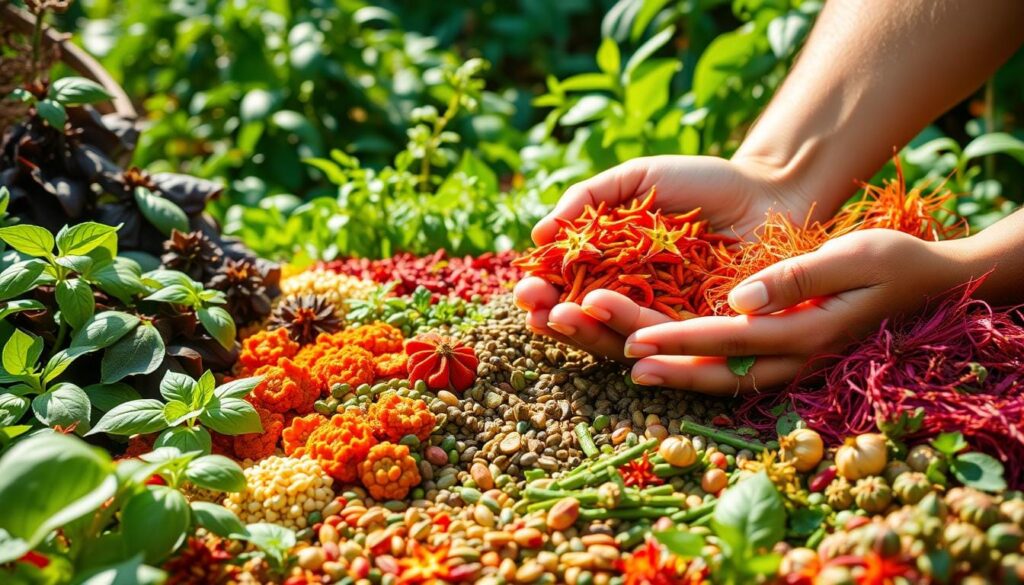
Our guide shows the most common mistakes that can hurt your sustainable spice production:
- Harvesting at the wrong time of day
- Using dull or unclean cutting tools
- Over-harvesting plant material
- Allowing herbs to flower before harvesting
- Improper storage techniques
“The key to exceptional spice quality is understanding your plants’ unique harvesting needs.”
Knowing when to harvest can greatly improve your herb yield. Regular harvesting encourages bushier growth, which can increase production. Experts say to harvest no more than one-third of a plant at a time to help it keep growing.
| Harvesting Error | Potential Consequence | Prevention Strategy |
|---|---|---|
| Dull Tool Usage | Plant Damage | Use Sharp, Clean Tools |
| Late Harvesting | Reduced Flavor Intensity | Harvest Before Flowering |
| Over-Harvesting | Plant Weakening | Remove Only 1/3 of Plant |
Timing is key in spice cultivation. The best time to harvest is early morning, when essential oils are most concentrated. Clean tools between each harvest to prevent disease and keep plants healthy.
By avoiding these common mistakes, you’ll have a bountiful, flavorful harvest every season in your home spice garden.
Maximizing Yield Through Proper Cultivation
Successful spice farming needs careful planning and the right cultivation methods. We start by understanding how plants grow and setting up the best conditions for them.
- Harvest herbs just before they flower to keep essential oils
- Prune plants often to help them grow
- Keep an eye on the soil’s health
- Use companion planting to help plants grow better together
“The secret to abundant spice production lies in understanding your plants’ unique needs and creating an environment where they can thrive.” – Spice Farming Expert
Studies show that smart cultivation boosts spice production. For example, regular pruning can increase leaf growth by up to 25%. Harvesting herbs in the early morning also makes them up to 20% more flavorful.
| Cultivation Technique | Potential Yield Improvement |
|---|---|
| Early Morning Harvesting | 20% Flavor Increase |
| Regular Pruning | 25% Leaf Production Boost |
| Proper Drying Methods | 50% Faster Preservation |
Our approach to growing organic spices focuses on sustainable environments. By knowing what each plant needs, we create strong farming methods. These methods improve both the quality and amount of spices.
Key takeaway: Successful spice farming is a mix of knowledge, patience, and careful cultivation practices.
Sustainable Practices in Home Spice Production
Creating a sustainable spice garden is more than just growing plants. It’s about building an ecosystem that helps your crops and the environment. Our focus on organic spices starts with finding the right balance between growing and protecting nature.
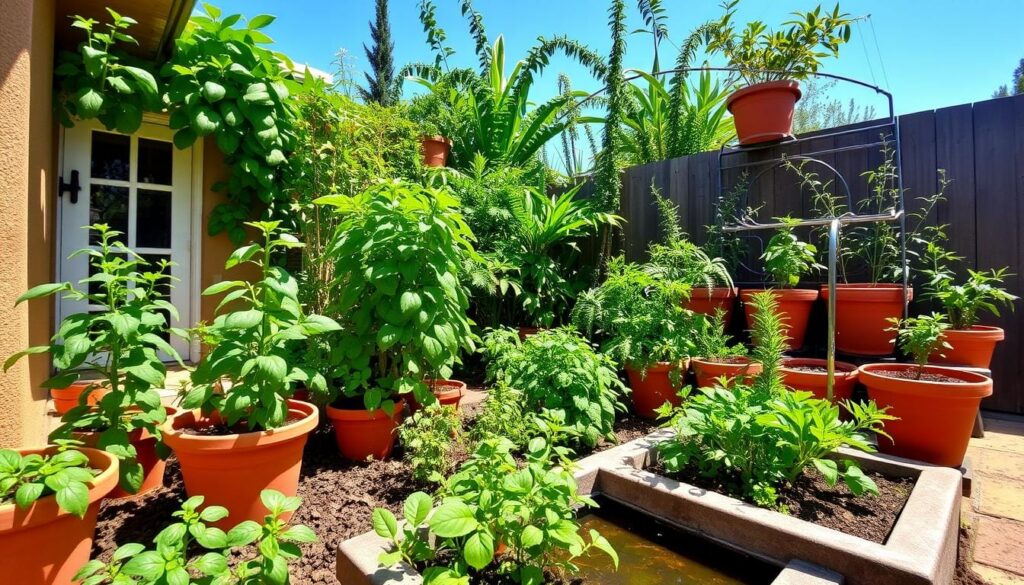
For sustainable spice production, gardeners can use several important strategies:
- Use organic composting methods
- Implement water conservation techniques
- Practice natural pest control
- Promote biodiversity in the garden
Environmental Considerations
Water management is key in sustainable spice production. Gardeners can save water by:
- Drip irrigation systems
- Rainwater harvesting
- Mulching to keep soil moist
- Choosing spice varieties that don’t need much water
Organic Methods
Switching to organic spices needs careful planning and dedication. Start with native and climate-friendly spice plants that grow well in your area.
“Sustainability is not just about growing plants, but creating a harmonious environment that supports long-term agricultural health.” – Sustainable Agriculture Research Foundation
| Sustainable Practice | Benefits |
|---|---|
| Companion Planting | Reduces pest problems naturally |
| Crop Rotation | Maintains soil nutrients |
| Organic Fertilizers | Improves soil health without chemicals |
By embracing sustainable spice production, we can create healthier gardens, support local ecosystems, and enjoy more flavorful organic spices.
Preserving Freshness and Flavor
Spice processing is an art that needs careful attention. Our homegrown artisanal spices must be preserved well to keep their flavors and aromas. Knowing how to protect the oils and essence of your herbs will make your cooking better.
- Air-drying in cool, dark spaces
- Freezing in pre-portioned ice cube trays
- Creating herbal vinegars
- Dehydrator processing
The secret to good spice preservation is knowing the best storage conditions. Temperature, humidity, and light exposure are key to keeping herbs fresh.
Proper preservation turns good herbs into amazing cooking ingredients.
Now, let’s look at how long different preservation methods last:
| Preservation Method | Shelf Life | Storage Recommendation |
|---|---|---|
| Dried Leafy Herbs | 1-3 years | Cool, dark pantry |
| Ground Spices | 2-3 years | Airtight containers |
| Frozen Herbs | Up to 1 year | Freezer at 0°F |
Our artisanal spices need careful handling. Always use clean, sterilized containers. Avoid moisture and direct sunlight. By using these preservation methods, your homegrown herbs will stay flavorful and potent.
Conclusion
Harvesting spices at home is an exciting adventure that connects us to our food’s roots. This journey shows that growing spices is both an art and a science. It turns simple cooking into a special experience.
The U.S. is a big spice consumer, but growing your own spices offers freedom. By learning about harvesting spices, we can make a spice collection that shows our taste. Each spice, from pepper to nutmeg, adds flavor and nutrition.
Home spice production is more than a hobby; it’s a way to eat healthier and sustainably. With the right care and techniques, anyone can grow a spice garden. It’s rewarding for both cooking lovers and gardening beginners.
We encourage you to start this rewarding journey. Begin small, keep learning, and see how your spice garden changes your kitchen. It will become a place of creativity and flavor.
